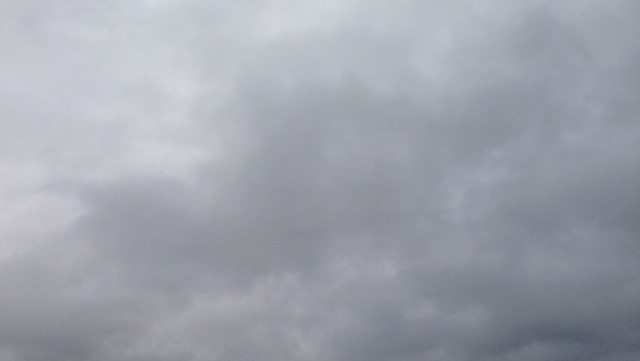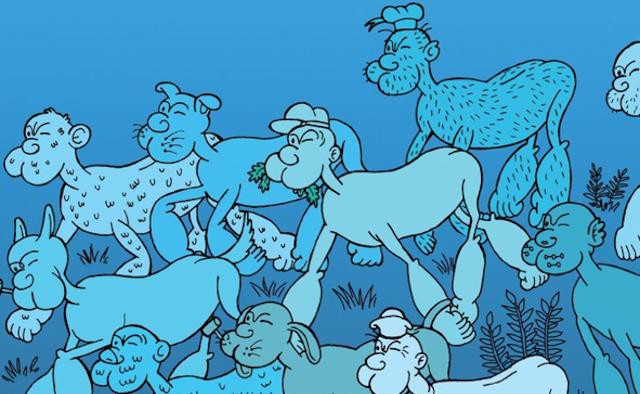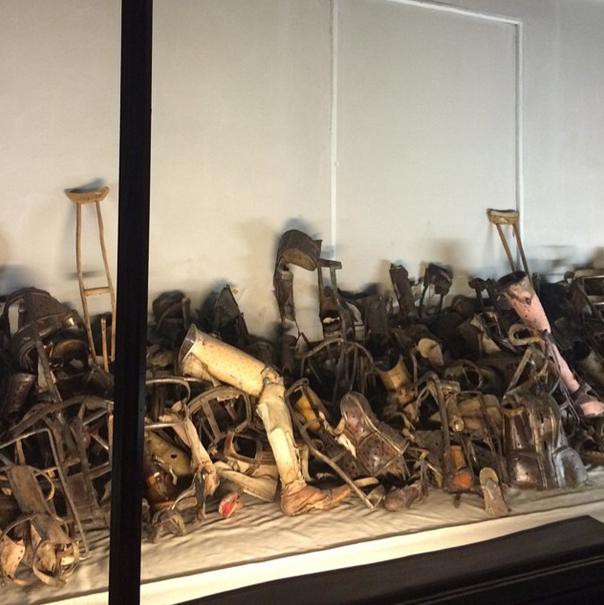The ClickHole Paradox
The ClickHole Paradox

ClickHole, The Onion’s new spinoff site, is funny. This wasn’t a given! It’s kind of a risky proposition, to make fun of a media just old enough to recognize but still too new to fully understand. The site is mean without coming off as bitter, it nails its tone. That is probably enough frog dissection: It is a good parody of the viral internet.
What it excels at now, though, is media criticism, which seems to be the source of what little backlash I’ve seen: How many times can you do the same list joke, or quiz joke, or Upworthy joke? But if you were to characterize The Onion proper as a media criticism project then it’s been doing the same half-dozen jokes forever: Fake news in deadpan voice, news trope gone surreal, stodgy editorial that goes off the rails after a few sentences — those are all accurate descriptions but don’t do justice to what The Onion actually does. These are reusable jokes that provide a starting point for new material. Writing something false in the recognizable voice of truth is an effective device only if what follows is also funny. It’s a setup.
And what we’re laughing at on ClickHole now are, for the most part, demonstrations of setups. They are pure criticisms of tone and form: Of the breathless celebrity tribute list, the manipulative video with a curiosity-gap headline, the highly specific personality-based quiz, the dramatic repackaging of obvious trivia (“5 Iconic Movie Scenes That Were Actually Fake”).
In feed terms, because this is really a site about madness caused by FEEDS, the first wave of ClickHole jokes are about Facebook and for Twitter. Twitter is where you make fun of Facebook,* and that’s what a lot of these posts indirectly do. In another context you might call this optimization. You might call it that in this context, too! But the real test for ClickHole comes when people start wielding it as a tool on Facebook itself, when, presumably, the site takes on individual social media news-fo-tainment phenomena in real time. If cable news shows seen by a couple million people a night are worthy of constant parody, why not viral videos shared and seen by ten times more?
WHICH BRINGS US TO THE PROBLEM.
You might share an article from The Onion on Facebook because it’s funny, and because it pokes fun at someone, or something, that you think is dumb or bad or irritating. On the latter you always have a little bit of deniability: It’s not about you, is your defense, it’s about [an ill-defined] them. Or you might say, to your angry cousin or old college roommate, that the joke isn’t about an election, it’s about the way the media covers the election. What’s different about ClickHole’s criticism is that it directly implicates people you know: On Facebook, there is no denying that they are the “them” you’re responding to; their behavior is an essential part of the media that’s being mocked. One of the best ways to get people to share CONTENT is to appeal to their identities, and identity-based content is difficult to talk about or criticize without making things seem personal.
The best case scenario is that ClickHole articles mingle in everyone’s feeds directly adjacent to the posts they’re making fun of, as answers or rebuttals or shrugs or accompaniments or some sort of vague equalizing force for…cynicism? If the material stays good, and why wouldn’t it, the whole thing might even feel sort of righteous. It could definitely work! It’s just kind of a lot to ask of people — it’s actually an AMAZING thing to ask of people, for your new website — to tell their friends that they’re idiots.
*And real life is where you make fun of Twitter.
New York City, June 11, 2014

★ A food cart’s row of light bulbs glowed conspicuously at midday, under the persistent gloom. Little raindrops had streaked the windows; the children had needed outerwear. Downtown, the sidewalk psychic stared blankly from her chair. It was not quite raining but not at all nice: neat raincoats and careless sunny-day clothes went by, equally uncalled-for. The late afternoon sky got around to brightening, indistinctly at first. East and north were blue and white, and Citi Bikes ticked past. Up at 79th Street, a shadow-casting beam of sunlight crossed the top of the crowded subway stairs. Now blue was to the south too, and overhead. The clouds over 66th Street looked inconsequential, but a solid, low-flying plane crossing over them dematerialized. Sun shone along the dinner table till the two-year-old complained and changed places. And then it was gray again, abruptly and thoroughly, the generous long bright evening canceled.
A Conversation with Patricia Lockwood
by Molly Minturn

I barged into the men’s, and felt stares burning
hard like reading or noon, felt them looking
me up and over, felt them looking me over
and down, and all the while just holding their
pens,
they do it different oh no they don’t,
they do it standing up
It’s a bit uncanny how these lines in “The Feeling of Needing a Pen” a poem in Patricia Lockwood’s new book, Motherland Fatherland Homelandsexuals, echo recent criticisms by a handful of discomfited reviewers. “They make me feel like the guy who ruins all the fun,” wrote Jonathan Farmer in Slate, in his review. Adam Plunkett, writing for the New Yorker’s Page-Turner blog, expressed concern that Lockwood was shaping her poems for her avid followers on Twitter, even going so far as to say that her best-known work, “Rape Joke,” is a poem that “probably wouldn’t have been written if Twitter hadn’t been around.”
Much has already been written about these reviews, from Mallory Ortberg’s excoriation in The Toast to Kat Stoeffel’s take in The Cut, in which she recommends that “‘Rape Joke’ should enter the canon forever and be required reading for all U.S. citizens.”
Listen to the sense of terrible captivity in these lines from “Rape Joke”: “The rape joke is that you were facedown. The rape joke is you were wearing a pretty green necklace that your sister had made for you. Later you cut that necklace up … The rape joke is that of course there was blood, which in human beings is so close to the surface.”
Now read these lines from “The Arch”:
… A city
cannot travel to another city, a city cannot visit
any city but itself, and in its sadness it gives
away a great door in the air. Well
a city cannot except for Paris, who puts
on a hat styled with pigeon wings and walks
through the streets of another city and will not
even see the sights, too full is she of the sights
already. And within her walk her women …
Lockwood’s poems, I realized as I read Motherland Fatherland Homelandsexuals, are Paris. They have a freedom, an ability to step outside all bounds and territories, to create little worlds woven through with metaphysical conceits, gorgeous and slightly world-weary.
I talked with her over email earlier this week about Motherland Fatherland Homelandsexuals, her experience writing it, as well as her thoughts about critical reactions to the book, and the best use of the word “Plunkett.”
There’s been a lot of talk about the supposed irreverence and suspicion of sincerity in your work. I actually found your poems to be full of empathy, especially for outsiders, like the man in “He Marries the Stuffed-Owl Exhibit at the Indiana Welcome Center” and poor Nessie in “Nessie Wants to Watch Herself Doing It.” Do you consider your work irreverent?
I am irreverent, but I don’t believe my poems are. The fact is that for all my modern vocabulary, I have an old-fashioned tendency to focus on characters — like Edwin Arlington Robinson except with lake monsters, and the thing they shoot themselves with in the end is profundity. Characters in poetry are a test of empathy, really. Can you project yourself into a myth? A mascot? A cartoon, or a waterfall? What is the most unlikely space you can think yourself into, can you look out through those eyes?
When I was reading your book, I kept thinking of it as a primer, maybe for girls, maybe for anyone who feels like an outsider, teaching us how to navigate this difficult world. In the first poem, the speaker is adolescent, witnessing confusing sex acts, and becomes a “homelandsexual,” perhaps as a way to keep safe. The last poem is in the voice of a hypno-domme, completely confident and powerful. Is there a sort of “journey” (ugh, forgive me for using that word) that the reader is meant to go on through your book?
Ordering a manuscript is one of the 12 labors; it frequently kills very muscular people. Sometimes it’s best to follow a rough chronology. I began with the earliest poem I wrote for the book and ended with the latest, so it wasn’t so much that I wanted to send the reader on a specific journey as that I was asking them to walk with me on mine — as I thought my way through a question, and ended on something that sounded like an answer.
Has anyone ever called you a metaphysical poet? I feel like you are the last of the major metaphysical poets; they’ve just been quiet for a few centuries.
I’m totally a metaphysical poet, with a ruff and a tiny pointed beard. Even as a child I was obsessed by the conceit: how to begin it, how far to push it, where its breaking point was. I felt the most nagging sense of incorrectness when the components of my writing refused to work together. Plus the metaphysicals were so dirty — people’s bloods were always having sex inside the same flea, and it was poetry! So yes, let’s say that they have risen up out of their GRAVE in the form of a rude patricia.
What do you make of Adam Plunkett’s review of your book, in which he expressed concern about your new poems being too crowd-pleasing and social media-ready?
I’m the absent-minded type, so I’ve always felt more detached and curious about reviews than personally affected by them. You know when your dog looks at you with its head cocked to one side, half “… go on” and half “I used to be a wolf”? That’s how I look at reviews. My main feeling about the Adam Plunkett review was that it had gotten the whole conversation off on something of a weird hairy foot, and led it down a path of reviews of reviews, and reviews of reviews of reviews, which eventually seemed to travel farther and farther away from the actual work.
In a strictly poetic sense it was delightful, because the name Plunkett is so euphonious, and if you wanted to pretend to be mad about the whole thing you could bellow PLUUUUNKETTTT! at the darkening sky while ripping your shirt open to the waist and shaking your fists at the clouds. That’s not an opportunity I’m ever going to pass up.
Did you have a particular audience in mind when you wrote Motherland?
Oh no, I never have an audience in mind. Or rather, the audience is the same as the one you put on shows for, in your room, when you’re a child engaging in the deepest and most private kind of play. It seems like the whole world you’re playing for, it seems like the eye of God up on the ceiling, but it’s really your own consciousness distributed among dolls. It couldn’t be anything else.
Were you surprised that some men (NOT ALL MEN) felt alienated by certain poems in your book? What is your response to that?
I was surprised to see these sudden dark hints that my poems might be “difficult for men to access” because such a large part of my readership and so many of my visible supporters have always been men, from the very beginning. When BPOB first came out, I had a stock of about 100 books that people could order directly from me and I’d draw in it for them and write a little message, and I’d say 75 percent of the people who asked for them were men. The people who published those supposedly difficult poems were men, often men at the helm of very traditional institutions. The characterization just didn’t seem particularly accurate — not to mention that it didn’t give men any credit for the fellow-feeling and sensitive readings I’ve always gotten from them.
So hold up, this is interesting, let’s take it all the way. I think these responses are less about alienation and more about vulnerability. The part of us that reads poetry is a reflex part. Men read poetry with their reflexes the same as women do — they put themselves in your trust, they put their bodies in your hands, you tap the right place and the leg kicks. Or the pupils dilate. Or the hackles rise, and something flies out of you on a flock of little red nerves. To feel power shift out of your body is uncomfortable. It makes you feel that it was never yours to begin with. That’s the whole point; that’s the subject here; and maybe what we are seeing is that it is more difficult for men — to recognize that they’re in someone else’s hands, to recognize that they’re at someone else’s mercy, when the author’s touch feels different, when the poems are these poems.
I read that Laura Ingalls Wilder was an influence when you were writing Balloon Pop Outlaw Black. Did she come into play at all with Motherland? Who or what else influenced these poems?
“What would happen if one writer told the truth about her influences? The world would split open.” I will say that I did watch the entire run of Star Trek: TNG for the first time ever when I was smack in the middle of writing, and that HAD to have had an effect. You might actually be able to see a point in the book where I start to wonder what it might be like to have sex with Worf. A slight pivot, a swivel of the eyes toward the question: would his cum kill you.
You said in an interview with Hazlitt: “The problem with me is that I can write individually, sentence-to-sentence, very well.” But you’re now working on a memoir for Riverhead. How is that going?
It’s exhilarating, really. There’s so much space, there’s so much room to play with form, you take a greedy breath and it just keeps going — the lung of it seems infinite. And there’s always some corner of it you can sit in and rearrange and dab paint on when you feel stuck. That’s not true of poetry. When you’re stuck with a poem, you’re stuck. Go to the turtle races and put all your money on the slowest one, because you’re not getting anything done today. But a big book gives great shelter.
Molly Minturn’s poems and essays have appeared in Boston Review, the Toast, the Indiana Review and elsewhere. She lives in Virginia.
Ruby Dee, 1922-2014
“Ruby Dee, an actress known as much for her civil rights activism as for her powerful stage and movie roles in productions including A Raisin in the Sun, has died.” She was 91 years old.
Instagrams from Auschwitz
by Leah Finnegan

One of the exhibits at the Memorial and Museum at Auschwitz Birkenau in Oswiecim, Poland, is a room of human hair. The room has an odd purplish tint to it, cast by the climate- and light-control systems that slow the hair’s decay. A display case holds two tons of human hair from an estimated forty thousand people. “Please do not photograph the room of hair,” Pawel Sawicki, a press officer of the museum and my group’s guide, told us. “We don’t know exactly when it will all turn to dust.”
Photographing the hair might hasten its disintegration. But also, the museum balks at letting patrons take pictures of human remains; a crematorium on the grounds of Auschwitz I, one of three Auschwitz camps in the Oswiecim area, where seventy thousand corpses were burned, is also off-limits to cameras.
Still, many take pictures. Crowds gather in front of the ARBEIT MACHT FREI gate in waves, photographing it almost synchronously, because you can’t not take a picture of it. Some people pose under it and have their companions take their pictures. A few people take selfies. It’s weird. Where does the impulse to take a picture of the entrance to a place of horror come from? Because hardly anyone took pictures when it was happening? As evidence that you have visited?
Sawicki, who is thirty-three, runs the social media operation of Auschwitz. Its Facebook page, which he started in 2009, has a hundred and twenty-three thousand likes. It has been on Twitter for two years, and Instagram for a year and a half. Sawicki said that the impulse for Auschwitz to go social was to make these experiences educational for users, and he haunts these channels to make sure that happens. If you post a picture to Instagram and geotag it at the Auschwitz Memorial, Sawicki might leave a comment under the username “AuschwitzMemorial,” explaining just what you’ve shared a picture of.
I asked Sawicki how he felt about people taking selfies at the memorial. “I think that there is some universal tendency in us — people — to document,” he wrote to me in an e-mail. “And a self-portrait made in a place that you visit is a kind of a proof that ‘I was there.’ Family albums are full of such pictures.” He continued: “But there are photographs being made — not only selfies — with a different motivation. If they just use the site as a background, if they are meant to be funny or are disrespectful in any way or they are manipulative, etc. — then of course this is simply wrong.”
Among the Auscwhitz selfies, several people are wearing headphones. This is not because they are listening to music (probably), but because the tours, which most visitors go on, are conducted via audio, narrated by the guide.
Another photo shows a group of women huddling at a memorial wall in a courtyard where prisoners were executed by shotgun. There’s a comment in Thai on the photo, reminding us that the visitors to Auschwitz come from all over the globe. A photo of a man in silhouette, walking in the hallway of a converted barrack, is tagged with #vsco hashtags. It has twenty-five likes.

Many of the photos tagged at Auschwitz are repetitive. The iconic images seem to be piles of children’s shoes; the train tracks at the camp; suitcases, names handwritten on them in large letters, because the prisoners were told they would be returned after a shower; and a tangled mess of eyeglasses, which Sawicki told us were just organized to be “more orderly.”
I wondered how these photographs — amateur and otherwise — were fitting themselves into some new niche of a history of a place that reverbs with ghostly meaning. The many arguments against photographing and sharing images of Auschwitz and Nazi terror have gone on for decades. Janina Struk, a photographer and writer, argued in her book Photographing the Holocaust: Interpretations of the Evidence, “The Nazis took photos of their victims to humiliate and degrade them. Are we not colluding with them by displaying them ourselves?”
The ambiguity about atrocity photography exists behind the camera as much as in front of it. It’s an understanding among journalists that some reporters use cameras as a defense mechanism — a means of protection between them and an uncomfortable subject. George Rodger, who photographed piles of dead bodies at Bergen Belsen for LIFE magazine, later recused himself from taking photographs of atrocities. “The natural instinct as a photographer is always to take good pictures, at the right exposure, with a good composition. But it shocked me that I was still trying to do this when my subjects were dead bodies,” he said. “I realized there must be something wrong with me, otherwise I would have recoiled from taking them at all.”
If you’re tooling with a camera, you don’t have to pay total attention to, or interact in fully human manner with, whatever is occurring in front of you. Susan Sontag, in her essay “On Photography,” wrote that there “is an aggression implicit in every use of the camera.” I thought about this while touring the camp. Can we be aggressive toward remains? Can they be over-photographed? Or do we need to see them anew, from different perspectives, until they disintegrate, like the room of human hair?
The day after we visited Auschwitz I, Sawicki took our group to see Auschwitz II-Birkenau, which is about a mile away from the first camp. The heat was oppressive and forest-y Birkenau, built on a swamp, had given birth to a hungry colony of mosquitoes. It’s the worst place I’ve ever been to, even though there’s hardly anything there now but piles of bricks.
The ground is shifting at Birkenau, so the buildings are coming apart. We went into a wooden barrack that was built for fifty-two horses but instead housed four hundred men. We walked through the rooms where bodies were shaved and examined. We heard about how fat from burning bodies in open-air fire pits was saved and poured over the other bodies in the pit so they would burn faster.
Few photographs came out of the Auschwitz camps. Wilhelm Brasse, a prisoner at the camp, was used by officers for his photography skills; he took an estimated forty to fifty thousand entry portraits of prisoners before the SS decided it would be more efficient to tattoo prisoners. Members of the Sonderkommando, a squad of Jewish prisoners made to carry out grisly tasks such as corpse burning, took grainy photos with smuggled film. Many prisoners brought photographers from home with them; they were burned by the SS.
Sontag also wrote about the fragility and volatility of the photograph, “plagued by the usual ills of paper objects; they disappear, they become valuable, and get bought and sold; they are reproduced.” This is in large part no more. Of course, there are still some photos that are worth more than others. But a digital photo enters a modern canon of existence; it can automatically become sorted, indexed, and filed away into a new kind of history.
Before going to Auschwitz, some of the other journalists on my trip and I debated whether or not we would post photos of it to Instagram. Some people think there’s a line of decency, and a photo of Auschwitz crosses it.
But the impulse to continue photographing Auschwitz isn’t wrong. The number of survivors continues to dwindle, and time barrels on further and further from the event. We should keep posting — and sharing — photographs of places where horror has happened until these places inevitably disintegrate, even if the photo of such a place does not fit so neatly into a social network, where the crass language of the sharing community — “likes,” “hearts,” “selfie,” “re-gram” etc., etc., can denigrate the austerity of an image. If we use social media for only the happy or banal events in life — weddings, brunches, signs with terrible grammar — well, why bother?
In her last book, Regarding the Pain of Others, Sontag went further: “Narratives can make us understand. Photographs do something else: they haunt us.” Therefore, let us ask: What are you doing when you “like” a photo posted at Auschwitz? You’re not “liking” the Holocaust. You’re acknowledging that the history is real.
Leah Finnegan is a journalist. Support for her trip to Auschwitz was provided by FASPE.
Correction: The barrack housed men, not women.
Nothing Will Ever Be Good Again
Nothing Will Ever Be Good Again
For more than a century, the pace of growth was reliably resilient, bouncing back after recessions like a car returning to its cruising speed after a roadblock. Even after the prolonged Great Depression of the 1930s, growth eventually returned to an average pace of more than 3 percent a year. But Treasury Secretary Jacob J. Lew, citing the Congressional Budget Office, said on Wednesday that the government now expected annual growth to average just 2.1 percent, about two-thirds of the previous pace.
Perhaps, after you have imported your dreams directly into an Oculus Rift, you could grant Facebook the rights to them in perpetuity in exchange for a single share of stock, which you could then maybe one day sell to pay your record-high rent, since there is clearly no other hope for the future.
Do You Have a Question for Evelyn Everlady?

There are few things I hate in this world more than unsolved mysteries. (SURE, EVEN, YES, WHERE IS THAT PLANE?) To that end, we have left you hanging regarding resolution of the tales of Evelyn Everlady, a woman in New York City who once had the worst boyfriend in the world ever, and who brought us the unfortunately now-real phrase Negroni Season. (As well as the tale of Hank the dog and the chilling story of Foxwoods.)
Next week she’s going to bring us up to speed, answering all my questions — but also yours, if you like! If you have any questions for her, you can leave them here, or shoot them to notes@theawl.com, and we will put them to her. I can tell you in advance that the terrible story of the worst boyfriend in the world… takes an even more terrible turn. Men! Can’t execute them all, can’t ban them from society entirely. Or can you.
Screenshot of Shutterstock search results for “all the single ladies.”
Workplace Innovation Stifled
“A federal agency sued a New York customer service provider on Wednesday after allegations the company forced employees to pray, thank God for their jobs and say ‘I love you’ to managers and colleagues at work, and fired those who protested… The company fired several employees who refused to adhere to the Onionhead doctrine, which was created by the aunt of the company’s owner.”
